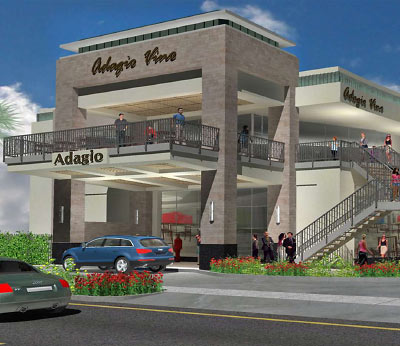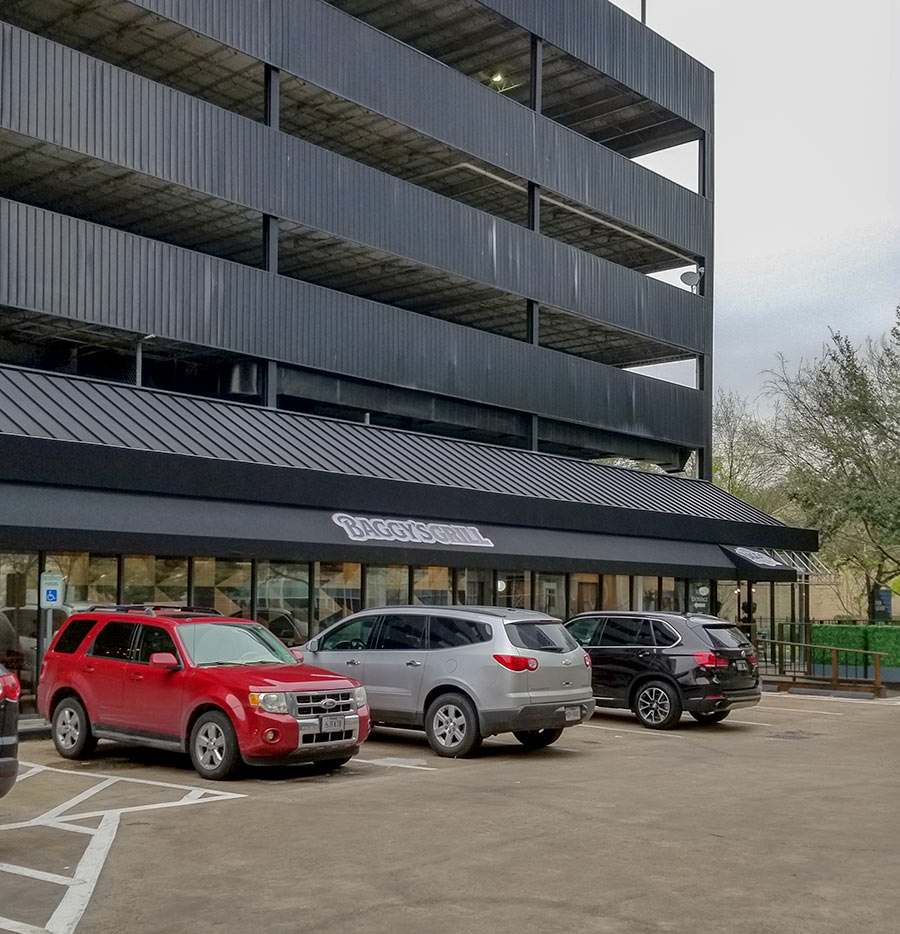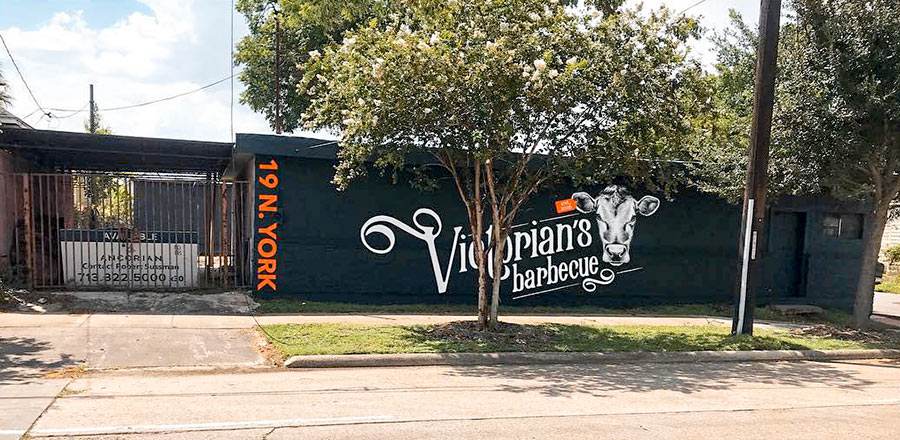
Weingarten had no problem tearing down the first part of the River Oaks Shopping Center last year. But when it decided to replace the historic curved building at the northeast corner of West Gray and Shepherd with the semi-curved, semi-modern confection shown here, did the company go too far?
According to the GHPA, Weingarten is now seeking a variance to allow it to keep changes it made to the approved plans for the building — which have already been built. From a website referred to in a GHPA email:
The restaurant’s balcony facing Shepherd encroaches into the mandatory setback, violating Houston City Setback Requirements. Once the City was notified of the encroachment, construction of the encroaching porch was stopped—temporarily. . . . Weingarten Realty has requested that the Planning Commission grant a variance to permit this encroaching porch. Without objections from concerned citizens like you, the City will likely grant the variance request.
That restaurant is Jeff and Tony Vallone’s planned new Il Tavolo. After the jump, a portion of the Greater Houston Preservation Alliance’s message:
***

Concerned neighbors of River Oaks Shopping Center are opposing Weingarten Realty’s application for a retroactive variance for construction already begun on the site. The developer made unauthorized changes to the original plans that violate the City’s setback ordinance and is only now requesting a variance. Neighboring homeowners are organizing to oppose the request when the issue comes before the Houston Planning Commission on Thursday, December 18. Details are online at www.stopshepherdnoise.org.
- Stop the Noise—Before It Starts! [Stop Shepherd Noise]
- Neighbors fight retroactive variance for Weingarten Realty [Old6WardHouston]
- River Oaks Shopping Center Replacement: Vallone at the Top [Swamplot]
- River Oaks Shopping Center Redo: Not Much of a Curve, but a Decent Wedge [Swamplot]
- That Enormous Parking Garage Behind the River Oaks Shopping Center [Swamplot]
Renderings of River Oaks Shopping Center on Shepherd Dr. at W. Gray: Weingarten Realty





Trade them a variance for a guarantee to leave the River Oaks Theater intact for 50 years (or whatever). Otherwise, who cares?
They’ll get the variance. And no, it’s not an evil developer getting its way.
The set back ordinance is in place to allow drivers at a corner to see down a roadway for oncoming traffic.
This particular encroachment does not impair or violate the spirit of the setback requirements. What’s funny, a whole lot of groups in the center of the city is doing what it can’t to ease setback requirements to allow more “urban” style construction.
On top of that, the real reason for this complaint is that the GHPA is pissed off that someone wants to change their own property to better suite its customers.
I re-iterate: If you want to save the theatre and potentially the rest of the art deco styling of the buildings, then buy all mean buy it from Weingarten. They have a price tag that is acceptable to sell this property.
that would be a shame if they weren’t able to include that balcony because of some bitter malcontents over progress.
The idea of a setback there is dumb. That stretch of West Gray is a dense, pedestrian friendly area where the street should be occupied by buildings, not parking lots or grassy expanses of nothing. Heaven forbid there might be some life and people walking around!
It’s also rather hard to believe that the same balcony won’t generate noise 20 feet back.
These people should move out of Montrose, for heaven sake. There are lots of quite suburbs and retirement homes out there for old timers.
kjb434, I want to make it clear I was trying for some humor re: the theater deal. I think the people using the variance hearing as a way to somehow penalize Weingarten is misguided at best. I totally agree with what you said about buying it if you want it that bad.
The balcony looks fine to me. It doesn’t say anywhere how far it extends over the setback, but how far could it be? And, as pointed out above, the noise would be the same either way. And: how about that garish illuminated sign (that acutally looks quite tasteful to me)?
I suspect that this group of concerned neighbors is jealous of the “Stop Ashby Highrise” crowd, with all their fancy stickers and yard signs and funny angry building logo, and they want something to protest as well. I mean, it’s tough to go to a dinner party and not have a local anti-development cause to be sanctimonious about. Yeesh.
Thanks for this article. I believe that developers and builders act on the philosophy that ‘It’s easier to ask for forgiveness than to ask for permission’. Weingarten could have applied for a variance before extending the construction. Why didn’t they? Do they assume or even know that money and power hold sway over regulations at the city’s planning commission? I hope the planning commission demonstrates that the rules apply to EVERYONE; perhaps at lease a substantial fine is in order.
FYI: Those opposing this project and variance are not against Weingarten, they are not against progress nor are they jealous of the Ashby Highrise crowd, it is just a matter of wanting to save our tangible history. Progress and preservation can work together, unfortunately, Houston has not caught up with the rest of the country on that topic.
Darby Mom,
Even though they didn’t make the request, the Planning Commission could still approved it.
There are many of times things get approved that should have had a variance, but they were so minor that the commission lets them go. This happens to big and small developers.
It would be interesting to see the original Planning Commission meeting minutes or video (if there was one). Potentially there was not an approval needed since this project is a redevelopment of an existing project and didn’t require a re-plat.
sstas,
You are more than welcome to save your tangible historic memories in physical form. The simple way to save it is to buy it.
kjb, you’re right, and that should be the only way. Only people with money should have the right to complain about things in their city they don’t like. And only if they’re willing to spend that money to purchase what they don’t like.
sstas:
While I agree that HOUTX should do something (anything) to preserve its history, the time to confront Weingarten was before the original building was torn down. To fight them over a minor variance on the garish monstrosity that’s replacing it is just silly. Even if it’s changed to conform it will still be a garish out-of-place monstrosity. (in my opinion, of course)…
Andrew
Who said only people with money?
That has nothing to do with it. What we are discussing is real property. It has a value to the owner.
The only fair way to save a historic building is to properly purchase it from the owner or to convince the owner it’s worth it to no alter the existing building. Any other method reeks of tyranny.
Parts of this shopping center or nearly 80 years old, some sections are younger. The problem is that this new building 80 years from now would be historic then…
Art Deco architecture was the popular fad at the time and wasn’t consider something to save until many years later. Maybe this style will do the same. You’re dealing in a world of opinion and emotion when you want to force someone else not to alter there own property.
In a d-e-m-o-c-r-a-c-y, people of all income levels, educational levels, political persuasions, races, creeds, etc–have a voice. No arguments there, right? We observe the relentless one-note tune that amounts to ‘he who has the gold, makes the rules’. (i.e., if you want to save it, buy it) And that’s true far too much of the time. It’s also why groups of people with similar ethics, values, and respect for written regulations unite to make their voices heard. On occasion, a landmark is saved or free, open access to a public sidewalk is preserved by constituents with limited financial resources. Is it not obvious that protest, whether successful or unsuccessful, does not ‘reek of tyranny’? But enough of engaging in a war of words with the unarmed.
That’s why coalitions form to “buy” historic places or to preserve places.
11th Street Park was a recent example in Houston. Neighborhood groups gathered together to purchase the land. Originally it was owned by HISD. The district was going to sell it to a developer. The community has been using it as a park and didn’t want to loose it.
Money was raised and along with a local bank and some help from a developer, a good 75% of the land was saved as a park which will be turned over to the city. The remaining 25% went to the developer to develop. The portion of the park land the community used for trails, baseball, and other recreation was saved.
None of these people were rich by any means. They were average citizens that took this upon themselves to save the property. Which I think that makes them extraordinary people.
Why can’t this be done with any other “historic” or “landmark” property?
HISD wasn’t expected to just not do anything with its own property so the neighborhood can keep its park. Weingarten should be expect to not do anything with its own property that will further their business as they see fit.
To kjb434:
It is obvious you are a developer of some kind and therefore do not understand the want of an economically challenged person to save a bit of history. Preservationists do not want to prevent anyone from earning a profit we just want to keep what little we have left. Profit and preservation can go hand in hand, if only the developers would take the time.
Lets also keep in mind that Weingarten owns 300 shopping centers across this country, I doubt they would have lost much profit if they had just worked with the community to create a design more compatible with the historic structure. Who did they build this for anyway? Certainly not for the local neighborhood, many of whom opposed this project. Weingarten is in danger of ruining their name…if they haven’t already!!
fyya,
You must be new to reading on this blog. If you read the Ashby blog entry, you would see people have accused me of being a developer before.
Let’s not resort to name calling. I’m a civil engineer in the area of hydraulics and hydrology (drainage). My license number is 98442. Look it up on the Texas Board of Professional Engineers website. I work for private engineering firm that work for local municipalities, communities, neighborhoods, and developers.
This shopping center doesn’t just serve the immediate neighborhood. It serves a much larger area. Weingarten is wise to expand the existing property versus say bulldozing a row of older homes down the way closer to Montrose for a new shopping center. Sure it would save the theater, but the community would still have some opposition.
As for economically challenged persons trying to save a piece of property, did you read my previous post? These people worked for at least two years to save the open space and succeeded.
In the River Oaks Theatre controversy, I don’t see that kind of commitment. Just people that are complain and spouting words and not doing anything about it. If the theater truly means that much to the community, they would actually do something about versus just filling a petition or walking with some signs.
As much as I disagreed with the Stop Ashby group, they at least were organized in their movement. They read up on the rules that affect the development and challenged the project. In the end, the same argument goes for them though. They should have came together and buy the property and then do with it as they wanted.
As for Weingarten not losing much profit if they back down this time, it makes no sense. If they do it this time, wouldn’t they risk at all 300 shopping centers having neighborhoods doing the same thing?
Kyle you go gurl.
There are limitations and responsibilities that come with owing historic properties. If Weingarten didn’t want the limitations and opposition to demolition, they could have never purchased the property in the first place. It didn’t become historic overnight.
If you don’t want limits and meddling, don’t buy a historic property. It’s akin to folks that buy a home next to an airport then complain about the noise.
Where are these limitation and responsibilities written?
The only place would be on the deed to the property if a restriction was in place, but it isn’t.
Many neighborhoods have these restrictions written into their deeds. This means when you buy the property you agree with any restriction. As for as I know, the theater doesn’t have this restriction. On top of that, when Weingarten bought this place, I’m sure it wasn’t considered a historic landmark. Weingarten owns another art deco theater on Shepherd that’s a retail commercial space. Where were the cries to save it then? Was it not historic that many years ago? When was the magic line that made this theater and shopping center historic and therefor untouchable?
Just because a small group of people don’t like what you are doing doesn’t mean you have to stop. If historic preservation was a true concern to the majority of the neighborhood or the city’s citizens, real action could be taken. We are not a place that places our value in the past. Houston has always been a place to look to the future. That culture isn’t going to change anytime soon. It’s what makes this city what it is.
“The only fair way to save a historic building is to properly purchase it from the owner or to convince the owner it’s worth it to no alter the existing building.”
The unspoken assumption behind this line of argument is that the value of a piece of real estate is determined entirely by the property itself and not what surrounds it. Which we all know is not true. If the houses on either side of mine were torn down and replaced by light industrial properties, my home’s value would drop. This is also why suburban HOAs vigorously enforce rules about appearance of homes (though the rules are often misguided, in my opinion).
Part of the value of any property is its context – s group of historic bungalows organized into a human-scale, walkable neighborhood each are individually more valuable than identical bungalows plopped in the middle of field, or surrounded by freeways.
If it’s legitimate for a suburban development to limit what people can do with their properties, why is it not legitimate for an urban neighborhood to restrict what property owners can do to their properties that would affect the overall quality of the neighborhood?
Now, one can certainly argue about whether particular attempts to do this are the right approach or misguided and whether they will achieve that aim in a sensible way, but the idea that the concept itself is somehow tyrannical is just a lot of dogmatic rubbish.
Judging from some of the comments, many folks have not read the StopShepherdNoise.org website to understand the issue, so let me explain why people are upset about this illegal encroachment. This is not a bunch of hothead activists, and this is not about preservation. We are not anti-developer and we are not anti-Weingarten.
Weingarten is asking for a variance, retroactively, to build a outdoor wine bar into the setback. Neighbors are rightfully opposed to the encroachment. It violates the setback, and the setback is a public asset that belongs to all of us.
Whether you yourself value the space we have in Houston between our roads and the buildings that line the roads is your own opinion, but many, many people do. Why do we have setback requirements? For sunlight, for fresh air, for a tiny bit of nature and space – one reason Houston does not look like Manhattan (at least not yet) is because we have setback requirements. We don’t have zoning in Houston – but we do have setback ordinances and building codes. This encroachment violates those laws.
What Weingarten has done by building a balcony into the setback, is to take a public asset, and sell it to their own tenant. It is not theirs to sell.
Several hundred people have signed paper and online petitions on this subject in the four days that have elapsed since Weingarten applied for this rushed variance hearing (which is at City Hall next Thursday December 18 at 2:30 pm). Those people, and tens of thousands of others like them, believe that city ordinances should be obeyed and not violated.
These folks also remember that last year, Weingarten spent considerable time and effort building trust and support from neighbors and other community groups after a huge public outcry. In meetings with the neighbors, the preservation alliance, and city’s historical commission, they distributed drawings showing what the redeveloped center would look like. That drawing can be viewed at StopShepherdNoise.org.
Many of us attended the meetings in which Weingarten distributed those drawings, and heard them say that they wanted to assure us all that they were going to respect the community desire to maintain the look and feel of the main shopping center, and specifically assured us all that the new building would “maintain the original footprint and curve of the building, but would merely be two stories tall instead of one.” But just look at what they actually built, compared to what they promised to build. It is nothing like what they promised in their “trust us” world tour. This part of the problem is not a violation of any law. But it is a serious violation of trust.
Will Weingarten get away with violating the law in the process of simultaneously violating public trust? Will they get away with taking a public asset and selling it to their own tenant, while simultaneously violating the “quiet enjoyment†of our residential neighborhoods? Will Weingarten respond to the valid concerns of its community by changing its plans to address the issues it has created? We will see – it depends on all of us.
We really have been humbled by the huge response to this four day old movement. It’s a shame Weingarten is trying to force this through the system with virtually no time for the interested public to find out about the issue and do something about it. We can only hope that those reading this post will make their voices heard as well. Thanks for your patience with this long post.
Where is Howard Roark when we need him?